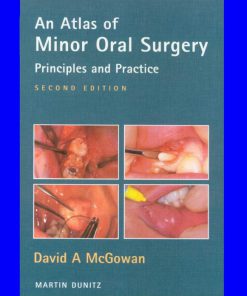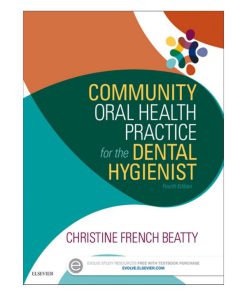Oral Health Epidemiology Principles and Practice 1st Edition by Amit Chattopadhyay ISBN 1284065715 9781284065718
$50.00 Original price was: $50.00.$25.00Current price is: $25.00.
Authors:Amit Chattopadhyay , Author sort:Chattopadhyay, Amit , Ids:0763754099 , Published:Published:Mar 2010
Oral Health Epidemiology Principles and Practice 1st Edition by Amit Chattopadhyay – Ebook PDF Instant Download/Delivery. 1284065715, 9781284065718
Full download Oral Health Epidemiology Principles and Practice 1st Edition after payment

Product details:
ISBN 10: 1284065715
ISBN 13: 9781284065718
Author: Amit Chattopadhyay
he overall goal for this book is to provide understanding that will prepare readers to be: skilled in epidemiologic, clinical-translational research approaches to oral health write complete research grants design proper studies translate their findings to practice conduct logical critique of scientific literature effectively communicate their ideas recognize the value of collaborative research interactions lead and inspire others to accomplish mutual research objectives translate their findings to practice make ethically correct decisions be sensitive and harmonious in relationships with their peers. Important Notice: The digital edition of this book is missing some of the images or content found in the physical edition.
Oral Health Epidemiology Principles and Practice 1st Table of contents:
SECTION I Epidemiologic Concepts in Oral Health
1 Definition and Background
FIGURE 1.1 Triad of Biomedical Science
Observational vs Experimental Epidemiology
Descriptive Epidemiology
Analytic Epidemiology
Assessing Association
Qualitative Research
Health Outcomes Research
Reasoning and Logic in Epidemiology
Disease Classification Systems
Manifestation Criteria vs Etiological Criteria
Infectious Disease vs Noninfectious Disease
Chronic Disease vs Acute Disease
Neoplastic (Benign vs Malignant) vs Nonneoplastic
Oral and Systemic Disease
ICD-9 vs ICD-10
2 Study Design
BOX 2.1 A Short Checklist for Designing a Study
Types of Study Designs: Observational Studies
Case-Control Study
Retrospective vs Prospective Case-Control Study
BOX 2.2 General Properties of Case-Control Studies
Population and Control Selection
BOX 2.3 Types of Controls
Case to Control Ratio
Power of Study and Sample Size
Prevalent vs Incident Cases
Case-Control Study Within a Defined Cohort
Nested Case-Control Studies
Case Cohort Study
Case Crossover Study
Cohort Study
BOX 2.4 General Properties of Cohort Studies
Population and Cohort Types
Exposure and Case Ascertainment
Case Ascertainment
Exposure Ascertainment
Loss to Follow-Up
Cross-Sectional Study
Types of Study Designs: Experimental Studies
Crossover Study
Split-Plot Design
Randomized Block Design and Other Designs
Types of Study Designs: Ecologic Studies
TABLE 2.1 Factorial Design
3 Associations and Causation
What Does an Association Mean?
Precision and Accuracy
FIGURE 3.1 Precision and Accuracy
Nature of Cause
FIGURE 3.2 Bland-Altman Plot
Types of Causes
FIGURE 3.3 Multiple Causation and Causal Interaction: Sufficient Cause Model
Causal Inference
Tests of Significance
Causal Paradigms
The Counterfactual Concept
4 Measuring Associations
TABLE 4.1 Measures of Association of Exposures and Outcomes
Measures of Association
FIGURE 4.1 Calculation of Person–Time
Correlation
FIGURE 4.2 Correlation
Odds Ratio (OR)
BOX 4.1 Probability and Odds Ratio
Risk Ratio
Hazard Ratio
Measures of Impact on Population
Risk Difference
Diagnostic Tests
BOX 4.2 Diagnostic Test Statistics with Worked Example
FIGURE 4.3 ROC Curve
Screening Tests
TABLE 4.2 Results from Hypothetical Studies are Presented Below to Demonstrate Relationship Between Sensitivity (Sn), Specificity (Sp), Positive Predictive Value (PPV), and Disease Prevalence
Agreement
Precision, P-Value, and Confidence Intervals
Systematic Review and Meta-Analysis
Systematic Reviews
Meta-Analysis
FIGURE 4.4 Generic Funnel Plot
FIGURE 4.5 Generic Forrest Plot
5 Error and Bias
FIGURE 5.1 Random Error and Bias
Random Error
Bias
BOX 5.1 Commonly Reported Biases Occurring in Epidemiological Studies
Selection Bias Example
TABLE 5.1 True Status of a Hypothetical Population
TABLE 5.2 Hypothetical Case-Control Study: Sample From Population in Table 5.1
TABLE 5.3 Hypothetical Case-Control Study: Biased Sample From Population in Table 5.1
TABLE 5.4 Hypothetical Case-Control Study: Biased Sample From Population in Table 5.1
Exposure Misclassification Example
TABLE 5.5 Hypothetical Case-Control Study
TABLE 5.6 Hypothetical Case-Control Study Demonstrating Nondifferential Exposure Misclassification
TABLE 5.7 Hypothetical Case-Control Study Demonstrating Differential Exposure Misclassification
TABLE 5.8 Hypothetical Case-Control Study Demonstrating Differential Exposure Misclassification
Misclassification of Disease Status Example
TABLE 5.9 Hypothetical Cohort Study of 2000 Persons Demonstrating Disease Status Misclassification
TABLE 5.10 Hypothetical Cohort Study Demonstrating Disease Status Misclassification
TABLE 5.11 Hypothetical Cohort Study Demonstrating Disease Status Misclassification.
TABLE 5.12 Hypothetical Cohort Study Demonstrating Disease Status Misclassification
TABLE 5.13 Hypothetical Cohort Study Demonstrating Disease Status Misclassification
TABLE 5.14 Hypothetical Cohort Study Demonstrating Differential Disease Status Misclassification Using Sample From Table 5.9
Control of Bias
Analytical Control for Selection Bias
Analytical Control for Measurement (Information) Bias
6 Confounding and Effect Measure Modification
Confounding
FIGURE 6.1 Confounding
Causal Diagrams
FIGURE 6.2 Directed Acyclic Graphs (DAGs)
Effect Measure Modification
FIGURE 6.3 Effect Measure Modification
TABLE 6.1 Overall Results From a Hypothetical Study to Assess Risk Factors of Oral Cancer
TABLE 6.2 Hypothetical Oral Cancer: Tobacco Consumption Study, Stratified for Third Factor (Xerostomia)
TABLE 6.3 Hypothetical Oral Cancer: Tobacco Consumption Study, Stratified for Third Factor (Education Level)
TABLE 6.4 Hypothetical Oral Cancer: Tobacco Consumption Study, Stratified for Third Factor (Alcohol Consumption)
TABLE 6.5 Effect Measure Modifications and Scales of Measurement
FIGURE 6.4 Interaction Contrasts
7 Analytical Approaches: The Data
BOX 7.1 Terms Commonly Used in Describing Data
BOX 7.2 Properties of Common Distributions
FIGURE 7.1 Shapes and Properties of Certain Distributions
FIGURE 7.2 Gaussian or Normal Distribution and Its Main Properties
FIGURE 7.3 Example of a Normal Distribution with Interpretation of Measure of Spread (Standard Deviation)
Types of Variables
Distributions, Parametric, and Nonparametric Tests
FIGURE 7.4 Distribution
Data Integration
Missing Data
TABLE 7.1 Types of Missing Data
Management of Missing Data
Data Imputation
Data Sources
Electronic Oral Health Records
8 Analytical Approaches: Analyses
BOX 8.1 Important Definitions and Steps of Hypothesis Testing
FIGURE 8.1 Comparing Distributions
The P-Value Conundrum
Time in Epidemiological Research
Statistical Tests
TABLE 8.1 Measures of Central Tendency and Data Dispersion of Variables
Setting Up the Analysis
BOX 8.2 Commonly Used Tests
BOX 8.3 Properties of Commonly Used Parametric and Nonparametric Tests
TABLE 8.2 Guide Matrix for Selecting Common Tests Under Common Situations
Multiple Comparison
Multivariable Analysis
FIGURE 8.2 Handling Multiple Variables in Analysis
Modeling
The Hierarchically Well-Formulated Model (HWF) Principle
Repeat Measure Analysis
Multilevel Analysis
BOX 8.4 Levels of Exposure for Dental Caries and Clustering in Oral Cavity as the Basis for Multilevel Analysis
Resampling
FIGURE 8.3 Example of Bootstrap Resampled Distribution of Means Across 50,000 Replications
Markov Process
9 Qualitative Research
Interpretation in Qualitative Research
Phenomenology
Grounded Theory
Ethnography
Narrative Analysis
Case Study
Critical Research
Postmodern Research
Data Collection and Analyses in Qualitative Research
Data Collection
Data Analysis
Data Analysis Software
10 Survey Sampling and Surveillance
Survey Sampling
Random Sample
BOX 10.1 Properties of Sampling Methods
Stratified Sample
Cluster Sample
Complex Samples
Analysis and Interpretation of Surveillance Data
Weighting and Variance Estimation
Validity and Reliability of Surveys and Surveillance Quality Control
Oral Health Surveillance in Practice
The U.S. National Oral Health Surveillance System
Global Oral Health Surveillance
11 Pharmacoepidemiology
Drug Development Process
Clinical Trial Process
BOX 11.1 General Properties of Clinical Trials
Drug Approval Process
Phase IV Clinical Trial: Postlaunch Safety Surveillance
Drug Safety and Adverse Drug Reactions
BOX 11.2 Types of Adverse Drug Reactions in the Orofacial Region Reported from a Variety of Drugs
Drug Regulatory Bodies Internationally
Notes on Design and Analysis of Clinical Trials
Bioequivalence, Noninferiority, and Superiority Trials
Placebo and Placebo Effect
BOX 11.3 Placebo and Placebo Effect: Variety of Conceptions
Blinding
Intention to Treat
Other Data Analysis Issues
Quality Control
Clinical Trial Issues in Dentistry
Ethical Issues
Medical Errors
Linked Automated Databases
The Food and Drug Administration and Dental Products
12 Molecular and Genetic Epidemiology
Molecular Epidemiology
Biological Molecules
BOX 12.1 Properties of Commonly Used Molecular Techniques and Principles
Sequence Analysis
Mutations
BOX 12.2 Types and Classes of Mutation
Polymorphism
Biomarkers
DNA Damage
Gene Expression Profiling
FIGURE 12.1 DNA Comet
Proteomics
Genetic Epidemiology
Steps in Genetic Epidemiology
BOX 12.3 General Methods Employed in Genetic Epidemiology
The Hardy-Weinberg Equilibrium
Population Stratification
Gene Flow
Genetic Drift
Gene-Environment Interaction
Analytical Issues in Genetic Epidemiology
SECTION II Epidemiology of Oral Diseases and Conditions
13 Dental Caries
Caries Detection
TABLE 13.1 Cariogenicity: Sugar and Nonsugar Sweeteners
TABLE 13.2 Decision Tree for Coding Coronal Primary Dental Caries
TABLE 13.3 Decision Tree for Coding Root Caries
Active vs Inactive Lesion
TABLE 13.4 Characteristics of Active and Inactive Carious Lesions
Caries Measurement Issues
Components of DMFT/S
FIGURE 13.1 DAG Showing Relationships Between SEP, Periodontal Disease, and DMFT Dental Caries Index
Adjustment for the M Component
Cavitated and Precavitated Lesions
TABLE 13.5 Precavitated Caries Follow-Up of Five Hypothetical Subjects
Root Caries
Caries Risk Assessment
Caries Prevention
Dental Caries Clinical Trial Design
14 Periodontal Diseases
Classification of Periodontal Diseases
BOX 14.1 Periodontal Disease Classification by the World Workshop on Clinical Periodontics (American Academy of Periodontology, 1989); and International Workshop for a Classification of Periodontal Diseases and Conditions (1999)
Measuring Periodontal Disease
Gingival Disease Measurement
Periodontal Disease Measurement
FIGURE 14.1 Clinical attachment loss assessment PD: Pocket depth; AL: Attachment level
BOX 14.2 Salient Features of Periodontal Indices
Measurement Issues in Periodontal Disease
Which Teeth to Measure?
What Is Measured as Periodontal Disease?
Analysis Issues in Periodontal Disease
BOX 14.3 Analytical Issues in Periodontal Disease
Periodontal Disease Surveillance
BOX 14.4 Self-Reported Questions to Assess Periodontal Disease Under Trial by CDC
15 Oral Cancer
Oral Cancer Scenario in the United States
U.S. Incidence
U.S. Mortality
Oral Cancer Survival
U.S. Survival
Lifetime Risk
TABLE 15.1 Relative Oral Cancer Survival Rates (Survival Period: 1976–1996)
TABLE 15.2 Survival Rates per 100,000 Population of Oral SCC in the United States
TABLE 15.3 Percent Diagnosed with Oral Cancer in 10, 20, and 30 Years and in Remaining Lifetime, Given Cancer-Free at Current Age by Sex
TABLE 15.4 Summary of Screening Tests for Oral Cancer
Screening for Oral Cancer: The Status of Evidence
Clinical Considerations
Risk Factors of Oral Cancer
BOX 15.1 U.S. Preventive Services Task Force on Screening for Oral Cancer (2004): Recommendations and Ratings
Tobacco
Alcohol
Human Papilloma Virus (HPV)
Protective Factors
Genetic and Molecular Epidemiology of Oral Cancer
Glutathione S-Transferase Enzymes
Cytochrome P450 and N-acetyl Transferase Enzymes
Alcohol Dehydrogenase
DNA Repair
16 Other Oral Diseases and Conditions
Oral Potentially Malignant Disorders
BOX 16.1 Characteristic Features of Some Important Potentially Malignant Disorders
Leukoplakia
HIV-Associated Oral Diseases
TABLE 16.1 Proportional Odds Model for Ordinal HIV-Associated Oral Diseases
Recurrent Aphthous Stomatitis
BOX 16.2 Purported Risk Factors of Recurrent Aphthous Ulcer (RAU)
Endodontic Outcomes
Oral Health and Systemic Health
Periodontal Disease and Cardiovascular Diseases
Periodontal Disease and Pregnancy Outcomes
BOX 16.3 Recommendations of “The American Journal of Cardiology and Journal of Periodontology Editors’ Consensus: Periodontitis and Atherosclerotic Cardiovascular Disease”
Periodontal Disease and Diabetes
Periodontal Disease and Other Systemic Diseases
Orofacial Clefts: Cleft Lip and Palate
17 Fluorides
Introduction
TABLE 17.1 Coverage of Fluoridation in Countries Serving 1 Million or More Population
Mechanism of Action
Dental Fluorosis and its Measurement
TABLE 17.2 Comparison of Indices for Fluorosis Measurement
BOX 17.1 Differential Diagnosis of Dental Fluorosis and Terms Used [(definition): synonyms/ alternative terms] in Describing Enamel Defects that May Be Confused with Dental Fluorosis and Should Be Included in Differential Diagnosis of Dental Fluorosis
Fluoride Exposure Measurement
Water Fluoridation
TABLE 17.3 Relative Ranking of Fluoride Alternatives by Different Criteria
Dental Fluorosis and Drinking Water Fluoridation
Design and Analysis Issues
Fluorides and Other Health Concerns
Water Fluoridation Policy
BOX 17.2 Recommendations for Using Fluoride to Prevent and Control Dental Caries in the United States
BOX 17.3 Fluoride Recommendation by International Health Agencies
Other Sources of Fluoride
Fluoride Supplementation
TABLE 17.4 ADA Council on Scientific Affairs Recommendations on Fluoride Dosage Schedule
Fluoride Toothpastes
Self-Applied Fluoride Rinses or Gels
Fluoride Mouth Rinses
Professionally Applied Fluoride Products
Salt Fluoridation
Milk Fluoridation
Other Fluoride-Containing Products
SECTION III Oral Epidemiology in Sociobiological Context
18 Social Epidemiology
Theories of Social Epidemiology
The Materialist Perspective (or Explanation)
The Cultural/Behavioral Perspective
The Psychosocial Perspective
The Life-Course Perspective
Poverty
Measuring Poverty
New Directions in Poverty Measurement
Development and Freedom
Race and Ethnicity
Oral Health Disparities
Existing Disparities in Oral Health
BOX 18.1 Summary of Existing Oral Health Disparities
TABLE 18.1 Stage Distribution by Race and Gender for Oral Cavity and Pharynx Cancer, All Ages
Predictors of Oral Health Disparities
Steps to Eliminate Oral Health Disparities
BOX 18.2 Guiding Principles on Developing Oral Health Interventions
BOX 18.3 Examples of Local and National Upstream Actions to Promote Oral Health
BOX 18.4 Steps Being Taken by States to Assess and Address Oral Health Disparities
Developing Measurement Instruments and Indices
FIGURE 18.1 Conceptual diagram for developing an index. Smaller individual factors are grouped into larger sequential groups. The factors and organized groups should be independent of each other. These grouped factors are finally summed up in some manner to lead to a final calculated statistic that functions as an index (sometimes simply stated as a total raw score or a weighted score of summed component scores across domains).
Factor Analysis and Principal Component Analysis
Propensity Score
Oral Health-Related Quality of Life
TABLE 18.2 Outline of Commonly Used OHRQoL Instruments
19 Bioethics in Oral Health
Principles of Bioethics
Other Ethical Principles
Ethical Handling of Information
Capacity
Informed Consent
Confidentiality
Disclosure
Veracity
Voluntary Information
Research and Publication Ethics
Research Ethics
Publication Ethics
Clinical and Research Ethics in a Globalized Era
20 Systems Thinking
Systems Science
Modeling with Systems Approach
Data Sources
Systems Modeling Software
Modeling Outcome and Significance
People also search for Oral Health Epidemiology Principles and Practice 1st:
oral health epidemiology: principles and practice
oral health epidemiology principles and practice
oral health policy jobs
oral health policy
principles of epidemiology in public health practice 5th edition pdf












